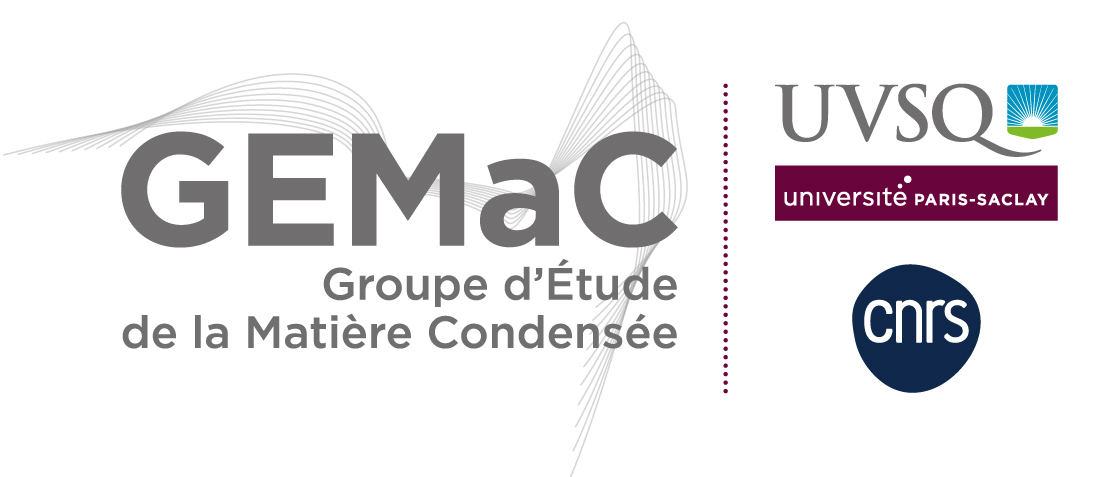- Partager cette page :
- PDF version
GEMaC laboratory presentation
The main mission of the GEMaC laboratory is to perform fundamental research with application perspectives, in the fields of physics and material science, with a view to addressing big societal challenges in the following topics:
- future information storage and processing
- green energies and high efficiency optoelectronics
- power electronics
Our research
In order to address these challenges, the whole laboratory capitalises on an expertise in condensed matter physics and material science, with additional expertise that is specific to our teams.
For instance, our competence include material synthesis, advanced characterisation, investigation of physical properties (structural, optics, transport, plasmonics, phase transitions) as well as in modelling and theoretical description, that go along with instrumental development.
In particular, we realise and investigate nanostructures (structures having nanometric dimensions in at least one of the three directions of space), heterostructures (nanostructures composed of several materials), and prototypes of elementary devices for electronics, optoelectronics, quantum information.
Finally, we perform fundamental physics experiments based on condensed matter systems, involving phenomena such as light-matter interaction, plasmonics, many-body effects, phase transitions...
The materials and phenomena we study
Research activities in GEMaC are based on several types of materials and semiconducting structures, in particular wide gap semiconductors, molecular materials, most often of nanometric sizes.
The experiments we perform and the phenomena we study involve a wide variety of problematics linked with our research thematics:
- Information processing and storage:
In the field of quantum information science and nanophotonics, we study the classical and quantum properties of CdSe/CdS nanocristals (at the scale of an individual object or in aggregates), as well as colour centres in wide gap semiconductor nanostructures.
We also investigate the properties of hexagonal boron nitride (hBN), which turns out to be a strategic material in the family of novel two-dimensional materials. When used as a substrate or for encapulation, it allows to obtain the best performances for structures based on graphene or other 2D materials (for instance MoS2) for applications in transport or efficient light emission.
- Green energy:
II-VI semiconductors is a large family of materials that includes wide gap ZnO and ZnS, that we study under the form of nano-objects and complex nanostructures owing to their very high light emission properties, allowing to foresee the realisation of white LED for domestic lighting.
- Power electronics
Another very promising, large wafer size available, ultra-wide bandgap material for high power applications is Ga2O3. We are fabricating and studying electronic properties of n- and p-type Ga2O3 epi-wafers for its integration in vertical, bi-polar device structures.
Our collaborations
Our laboratory benefits from a large network:
- firstly, local collaborations: there are many links between the various teams in GEMaC, leading to inter-team projects. Within UVSQ, GEMaC collaborates with ILV (institute Lavoisier Versailles)
- regional collaborations: we develop numerous collaboration with laboratories of Paris-Saclay university as well as other regional laboratories. For instance, we are leading the flagship AXION (labex NanoSaclay), that links together eight research teams.
- national collaborations: we collaborate with laboratories from various communities (semiconductor, magnetism, optics...)
- Finally, our laboratory also develops international collaborations. For instance, we are involved in the international associated laboratory IM-LED France-Japan, started in 2017. We also joined the European Graphene flagship in 2018.
Our research is funded by:

We have several projects in collaboration with companies such as start-ups Nanovation, Nextdot, as well as with cutting edge equipment manufacturers such as JEOL, CAMECA and ANNEALSYS.
Our expertise, our competences and part of our facilities can be opened to ponctual collaborations.

We have several projects in collaboration with companies such as start-ups Nanovation, Nextdot, as well as with cutting edge equipment manufacturers such as JEOL, CAMECA and ANNEALSYS.
Our expertise, our competences and part of our facilities can be opened to ponctual collaborations.
Contacts
GEMaC direction
direction.gemac@uvsq.fr
Financial management
admin.gemac@uvsq.fr
Human resources
rh.gemac@uvsq.fr
Communication team
comm.gemac@uvsq.fr





